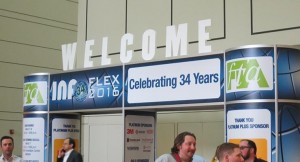By Greg Hrinya, Associate Editor | March 28, 2016
Automation, expanded color gamut and quick changeovers were among the technologies explored in the session.
Joel Engelberth, Esko, and Nicole Ross of Kodak co-chaired an in-depth discussion on the history and future of flexography in “Flexo Game Changers.” The presentation took place on March 7, 2016, as part of FTA Forum: Power of the past, force of the future. The show was co-located with INFO*FLEX, an exhibition featuring nearly 300 exhibitors and over 2,000 attendees.
FTA was formed in 1958, and Forum’s goal has always been to deal with industry issues. In addition, the event provides an exchange of information, training, troubleshooting and networking. Automation, expanded color gamut and quick changeovers were among the game-changing technologies explored in the session.
The ability to measure variables, such as various statistics and numbers, has quantified issues like press speeds and web tension. The science behind flexo, which was explored in a later presentation entitled “Preparing for the future,” has allowed manufacturers and printers to define productivity and quality. Such information can also be found in FIRST (Flexographic Image Reproduction Specifications & Tolerances), a manual dedicated to establish guidelines and simplifying applications.
“I feel like in the short time that I’ve been in the industry–between school and work–I’ve seen a good bit of changes along the way,” said Engelberth. “This is constantly evolving.”
“It required a great deal of collaboration initially,” said Paul Lancelle, flexographic system engineer at Eastman Kodak. “It began by identifying the variables in the process that could be documented and controlled. Initially, we did a great deal of trend analysis, and that led to regularly measuring variables like density and dot gain, ink viscosity and film surface treatment. We were then measuring anilox cells, press speeds and plate life.”

Forum was held concurrently with INFO*FLEX in Fort Worth, TX, USA.
Four speakers explained the new technologies to hit various segments of the printing industry, including narrow web, wide web, platemaking, and corrugated. John Crammer, general manager at Best Label, looked at the advantages LED curing has provided the narrow web label market. LED curing has provided a viable alternative to replace traditional UV mercury lamps. Among the advantages are an instant on/off setting that contributes to energy savings, fewer serviceable parts and longer lamp lives. These factors ultimately lead to faster curing and increased press capacity.
According to Bart Wright, print specialist at InterFlex, advances in modern flexo presses have contributed to a plethora of new special effects. Labels pop on the shelves with gloss, matte, metallic, and thermochromatic effects.
“There have been a lot of changes in the last five years or so with plates,” said Wright. “There is a lot of really cool stuff happening, but that has to work with everything else that’s in your shop. Everything has to be working together in unison.”
David Smith, Manufacturing Projects manager at CyberGraphics, said that advances in platemaking have changed flexography dramatically. Today, platemakers can form a one-to-one image from file to plate with flat-top dots and high-resolution imaging. The benefits of such technology include impression latitude, improved ink transfer with surface modification, durable dot structures and increased plate longevity. In addition, what is imaged on the plate stays on the plate.
High-resolution imaging translates into more pixels for finer image features and smooth microtype lines. According to Smith, the combination of flat-top dots and high-resolution imaging “is a game-changing feature, as you’re able to image microscopic surface features and hold them. This includes printing perfect solids, imaging rounder dots and keeping them, and enabling smoother fades to zero.”
Specialized raw materials, including flat-top plates, texturized surfaces and unique chemistries, have led to reduced workflows and equipment restraints, increased productivity and decreased redundancy concerns. Plates have also been optimized for LED exposure and made softer for white. These integrated systems have automated the workflow. This process includes operator tasks, operator decision-making, material movement, and system integration.
“There are process times that are not synchronized and not optimized, where imaging could take 20 to 30 minutes depending on the size of your plate, and you could load your processor every 10 minutes,” said Smith. “Getting those to work in sync is something we will have to overcome, and so until there is a solution, the ROI is a little hazy. We trust there will be a game-changing solution coming to the market very soon, and we’ll have an opportunity to see how that works and make decisions based on our particular workflows.”
Both Wright and Kevin McLaughlin, president of Flexo Concepts, noted that inks have improved, as well. There have been advances in ink delivery systems, machine improvement, as well as substrates and drying technology. Digital has also played a role.
“The one thing I want to talk about in ink is high-opacity white because brand owners want windows in packaging,” explained Wright. “People want to see and actually show the product versus an illustration. They want strong white ink that is going to be opaque and bright, so how do we the printers make that happen? Given what’s going on with ink, in combination with anilox rolls and textured soft durometer plates that can be achieved, it’s becoming a bigger subject every day in our industry.”
– See more at: http://www.labelandnarrowweb.com/contents/view_online-exclusives/2016-03-28/fta-forum-explores-flexo-game-changers/#sthash.foeZXl06.dpuf